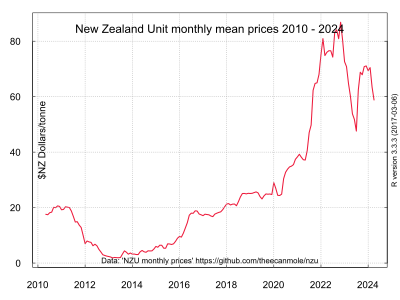
The New Zealand Emissions Trading Scheme (NZ ETS) is an all-gases partial-coverage uncapped domestic emissions trading scheme that features price floors, forestry offsetting, free allocation and auctioning of emissions units.
The NZ ETS was first legislated in the Climate Change Response (Emissions Trading) Amendment Act 2008 in September 2008 under the Fifth Labour Government of New Zealand[1][2] and then amended in November 2009[3] and in November 2012[4] by the Fifth National Government of New Zealand.
The NZ ETS was until 2015 highly linked to international carbon markets as it allowed unlimited importing of most of the Kyoto Protocol emission units. There is a domestic emission unit; the 'New Zealand Unit' (NZU), which was initially issued by free allocation to emitters until auctions of units commenced in 2020.[5] The NZU is equivalent to 1 tonne of carbon dioxide. Free allocation of units varies between sectors. The commercial fishery sector (who are not participants) received a one-off free allocation of units on a historic basis.[6] Owners of pre-1990 forests received a fixed free allocation of units.[7] Free allocation to emissions-intensive industry,[8][9] is provided on an output-intensity basis. For this sector, there is no set limit on the number of units that may be allocated.[10][11] The number of units allocated to eligible emitters is based on the average emissions per unit of output within a defined 'activity'.[12] Bertram and Terry (2010, p 16) state that as the NZ ETS does not 'cap' emissions, the NZ ETS is not a cap and trade scheme as understood in the economics literature.[13]
Some stakeholders have criticised the New Zealand Emissions Trading Scheme for its generous free allocations of emission units and the lack of a carbon price signal (the Parliamentary Commissioner for the Environment),[14] and for being ineffective in reducing emissions (Greenpeace Aotearoa New Zealand).[15]
The NZ ETS has been reviewed and amended many times: first in November 2009[3] then in late 2011 to 2012 by an independent panel.[16][4] A 2016 Government review concluded that the NZ ETS had caused only minimal reductions in net emissions. [17] In 2020 rules for emissions budgets and auctions of units within price caps were introduced.[18]
- ^ Parker, David (10 September 2008). "Historic climate change legislation passes" (Press release). New Zealand Government. Retrieved 10 September 2008.
- ^ "Climate Change Response (Emissions Trading) Amendment Act 2008 No 85". legislation.govt.nz. Parliamentary Counsel Office. 25 September 2008. Retrieved 25 January 2010.
- ^ a b Hon Nick Smith (25 November 2009). "Balanced new law important step on climate change" (Press release). New Zealand Government. Retrieved 14 June 2010.
- ^ a b "ETS Amendment Bill passes third reading" (Press release). New Zealand Government. 9 November 2012. Retrieved 12 November 2012.
- ^ "New Zealand Units (NZUs)". Climate change information New Zealand. Ministry for the Environment, NZ Government (www.climatechange.govt.nz). 18 June 2010. Retrieved 13 August 2010.
In the short term, the Government is unlikely to sell emission units because the Kyoto units allocated to New Zealand will be needed to support New Zealand's international obligations, as well as allocation to eligible sectors under the emissions trading scheme.
- ^ Cite error: The named reference
MfESept09was invoked but never defined (see the help page). - ^ Cite error: The named reference
forestwas invoked but never defined (see the help page). - ^ "Who will get a free allocation of emission units?". Questions and answers about the emissions trading scheme. Ministry for the Environment, NZ Government. 14 January 2010. Retrieved 15 May 2010.
- ^ MfE (September 2009). "Agriculture". Summary of the proposed changes to the NZ ETS - Emissions Trading Bulletin 11. Ministry for the Environment, NZ Government. Retrieved 16 May 2010.
- ^ MfE (1 September 2009). "Emissions trading bulletin No 11: Summary of the proposed changes to the NZ ETS". Ministry for the Environment, NZ Government. Retrieved 17 September 2022.
- ^ MfE (September 2009). "Industrial allocation update". Emissions trading bulletin No 12, INFO 441. Ministry for the Environment, NZ Government. Retrieved 8 August 2010.
The Bill changes the allocation provisions of the existing CCRA from allocating a fixed pool of emissions to an uncapped approach to allocation. There is no longer an explicit limit on the number of New Zealand units (NZUs) that can be allocated to the industrial sector.
- ^ MfE (14 January 2010). "How will free allocation of emission units to the industrial sector work now?". Questions and answers about amendments to the New Zealand Emissions Trading Scheme (ETS). Ministry for the Environment, NZ Government. Retrieved 16 May 2010.
- ^ Bertram, Geoff; Terry, Simon (2010). The Carbon Challenge: New Zealand's Emissions Trading Scheme. Bridget Williams Books, Wellington. ISBN 978-1-877242-46-5.
The New Zealand ETS does not fit this model because there is no cap and therefore no certainty as to the volume of emissions with which the national economy must operate
- ^ "New bill 'weakens ETS' says Environment Commissioner" (Press release). Parliamentary Commissioner for the Environment. 15 October 2009. Retrieved 15 October 2009.
The allocation of free carbon credits to industrial processes is extremely generous and removes the carbon price signal where New Zealand needs one the most
- ^ "Revised ETS an insult to New Zealanders" (Press release). Greenpeace New Zealand. 14 September 2009. Retrieved 12 October 2009.
We now have on the table a pathetic ETS which won't actually do anything to reduce emissions
- ^ "Issues statement for public consultation". NZ ETS Review 2011. Ministry for the Environment. 21 April 2011. Retrieved 4 November 2011.
- ^ "The New Zealand Emissions Trading Scheme Evaluation 2016" (PDF). Ministry for the Environment. 7 February 2016. Retrieved 31 October 2022.
page 40 "The NZ ETS appears to have contributed, but only minimally, to changes in behaviour and decisions that have reduced net emissions below business-as-usual levels."
- ^ Shaw, James (2 June 2020). "Emission trading reforms another step to meeting climate targets". New Zealand Government. Retrieved 31 October 2022.
© MMXXIII Rich X Search. We shall prevail. All rights reserved. Rich X Search
